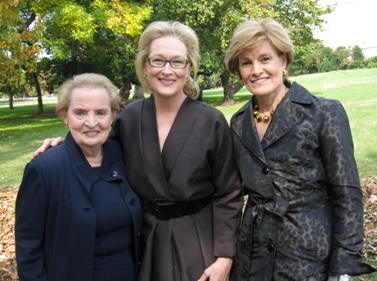Giving Women’s History a Home

Perhaps this year’s Women’s History Month will mark the success of a push for a National Women’s History Museum, a campaign that has built up an impressive history of its own.
March is Women’s History Month, when we celebrate the contributions of extraordinary women of the past. But while a month provides a meaningful focus for honoring women’s history, that awareness should be threaded into our culture and educational systems year-round. Such a goal is behind a movement to build a museum in Washington, D.C., organized by a group called the National Women’s History Museum (NWHM).
The project started in 1995, as a result of the treatment of a women’s suffrage statue. Joan Wages, the president and CEO of the National Women’s History Museum, explained that the monument of suffragists Lucretia Mott, Elizabeth Cady Stanton, and Susan B. Anthony was dedicated in the Capitol Rotunda in 1921, and then the very next day “the all male Congress moved it downstairs into a storage closet.” In the years that followed, Wages said that Congress “would come up with all of these excuses why they couldn’t move this statue.” In the 1990s, after a “big campaign, once again, by a number of women’s groups to ask Congress to move the statue and they didn’t do it,” Karen Staser founded the NWHM, explained Wages, a founding board member. Its grassroots campaign raised $85,000 and generated the support to move the statue back to the Rotunda on Mother’s Day 1997, where it now stands.
Wages described that experience as a powerful metaphor for what often happens to women’s history. “It comes to the light of day and then it’s stored away,” she said, in this case below the Rotunda in the U.S. Capitol Crypt. “What needs to happen is for women’s history to be made part of our national story.” While the NWHM has existed virtually for the past ten years at their website—and currently offers a robust gallery of 21 online exhibits—it has been campaigning since 1998 to get an actual, physical museum, on or near the National Mall. Although the museum will be privately funded, Congress has yet to authorize purchase of a plot, which is on federal land. Legislation to approve the sale has been met again and again with a range of cumbersome excuses and delays, much like the suffrage statue that inspired the museum’s founding. But an impressive cadre of influential supporters—including more than 200 members of Congress on its Honorary Board as well as Meryl Streep as national spokeswoman—is determined to break the impasse. Streep recently pledged $1 million dollars to the museum from her earnings for the film The Iron Lady, in which she plays British Prime Minister Margaret Thatcher. During her speech at a NWHM gala in 2010, the actress spoke about “the deep, psychological, spiritual, symbolic meaning of a building,” adding that museums “are especially important in Washington, D.C., seat of our national heritage, memorialized in marble and granite, glass, stone, and steel” not only as “symbols, but as gathering places, as inspirational spaces.”
According to Wages, Streep’s interest in the museum is personal. She said Streep would relate her grandmother’s stories of going after her grandfather on election day to “wrangle him off the golf course” and tell him who to vote for on the Board of Education. “He didn’t know as much about who was running and she couldn’t vote.” Wages added that, Streep “really gets it. She wants a better world for her daughters and her grandchildren.”
To Wages, women need an appreciation of their own history as the foundation for empowerment. “Men have had their history for thousands of years. They draw power from that. They learn from what men have done before and what works, what doesn’t work, what inspires them to move forward,” she said. Women, on the other hand, “essentially stand on what I called historical quicksand, because every generation loses this information about what women have done to build and grow our society and the world.” An historian told her, she added, “that every generation of women has to recreate the wheel,” by finding the courage within themselves to step out without knowing that a path has been broken by women successful “in business, in finance, in medicine, in mathematics, in computers, in all of these fields.”
In the latest action, legislation has passed out of committee in the House to approve the building site. However, Wages said, the committee chairman “ended up attaching another bill to ours and the other bill is very costly.” NWHM is now working with Congresswoman Carolyn Maloney, who has been their House bill sponsor, to “evaluate the best next step.” In the meanwhile, the NWHM has launched a “Right Here, Right Now” campaign at their website where supporters can contact their senators and urge them to champion The National Women’s History Museum Act. In her speech, Streep lamented that a bill “sponsored by the bipartisan women in Congress” has year after year been “pushed aside, neglected. Not deemed important enough.” It is maddening to her “that we still must kneel and beg our brothers in Congress to please let us build a museum that honors the achievements of their own mothers and grandmothers.”
Wages says her highest hope is that this museum “will help change the culture in a way that there’s greater value for what women provide to our society.” Streep said she is confident “that the whole family will feel, in that hall, the gratitude of neglected generations. And they will feel the awe that comes from breathing the cool air of respect for the aspirations and accomplishments of fully one half of humanity.”
For more information or to support the National Women’s History Museum, visit www.nwhm.org.
More articles by Category: Education, Politics
More articles by Tag: Women's leadership



























